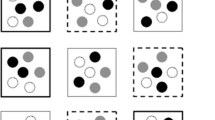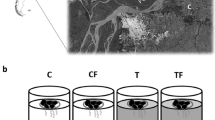Summary
During unusually wet years the salinity of the Great Salt Lake (Utah) decreased from above 100 g/L to 50 g/L. This allowed the predaceous insect Trichocorixa verticalis to invade the pelagic region of the lake and reach a mean summer density of 52/m3. Concurrent changes in the pelagic ecosystem were: a decrease in the dry biomass of the previously dominant filter-feeding brine shrimp Artemia franciscana from 720 to 2 mg/m3, the invasion of three other zooplankton taxa, a 10 × decrease in community filtration rate, a 20 × increase in chlorophyll a concentration, a 4 × decrease in water clarity and perhaps a decrease in soluble nutrients. Trichocorixa abundance was also inversely correlated with the abundance of Artemia along a salinity gradient in the lake's estuary. In a 9-d microcosm experiment Trichocorixa preyed on nauplii and decreased the total density of Artemia from 103 to 6/L. The reduction in Artemia allowed protozoans to increase 10–100 ×. Changes in chlorophyll and clarity were consistent with those observed in the lake. These results suggest that invertebrate predation may be an important factor structuring simple food webs such as those found in moderately saline lakes.
Similar content being viewed by others
References
American Public Health Assoication (1985) Standard methods for the examination of water and wastewater, 16th ed. APHA, Washington, DC
Bhargava SC, Jakher GR, Saxena MM, Sinha RK (1987) Ecology of Artemia in Didwanda Salt Lake (India). In: Sorgeloos P, Bengtson DA, Decleir W, Jaspers E (eds) Artemia research and its applications, vol. 3. Universa Press, Wetteren, Belgium, pp 127–134
Batra SWT (1982) Biological control in agroecosystems. Science 215:134–139
Carpenter SR (1988) Complex interactions in lake communities. Springer-Verlag, New York, 283p
Carpenter SR, Kitchell JF, Hodgson JR (1985) Cascading trophic interactions and lake productivity. Bioscience 35:634–639
Dana G (1981) Comparative population ecology of the brine shrimp Artemia. MS thesis, San Francisco State University, San Francisco, CA
Drinkwater LE, Clegg JS (1990) Experimental biology of cyst diapause. In: Brown R, Sorgeloos P, Trotman C (eds) Artemia Biology. CRC Press, Boca Raton, pp 93–117
Drinkwater LE, Crowe JH (1987) Regulation of embryonic diapause in Artemia: Environmental and physiological signals. J Exp Zool 241:297–307
Dodson SI (1975) Predation rates of zooplankton in arctic ponds. Limnol Oceanogr 20:426–433
Doohan M (1973) An energy budget for adult Brachionus plicatilis Müller (Rotatoria). Oecologia 13:351–362
Edmondson WT (1966) Pacific Coast and Great Basin. In: Frey DG (ed) Limnology in North America. Univ Wisconsin Press, Madison, Wisconsin, pp 371–392
Gillespie DM, Stephens DW (1977) Some aspects of plankton dynamics in the Great Salt Lake, Utah. In: Greer DC (ed) Desertic terminal lakes, Utah Water Research Laboratory, Utah State University, Logan, UT, pp 401–410
Gilbert JJ (1989) The effect of Daphnia interference on a natural rotifer and ciliate community: short-term bottle experiments. Limnol Oceanogr 34:606–617
Gulati RD, Lammens EHRR, Meijer M-L, van Donk E (1990) Biomanipulation — Tool for water management. Kluwer Academic Publishers, Belgium
Hairston NG, Smith FE, Slobodkin LB (1960) Community structure, population control and competition. Am Nat 94:421–425
Hammer UT (1986) Saline lake ecosystems of the world. Dr. W. Junk Publishers, Dordrecht, 616 p
Hammer UT, Hurlbert SH (1990) Is the occurrence of Artemia salina (L.) determined by the absence of predators or by salinity tolerance in some saline waters? In: Hammer UT (ed) Aquatic ecosystems in semi-arid regions: implications for resource management. National Hydrology Research Institute, Saskatoon (abstract)
Hayes CR (1971) Distribution, populations, and species diversity of phytoplankton and zooplankton of Farmington Bay. In: Carter CK (ed) Some ecological considerations of Farmington Bay estuary and adjacent Great Salt Lake State Park. Available from library, University of Utah, Salt Lake City, Utah, pp E2 E21
Herbst DB (1988) Comparative population ecology of Ephedra hians Say (Diptera: Ephydridae) at Mono Lake (California) and Albert Lake (Oregon). Hydrobiologia 158:145–166
Hrbacek J, Dvorakova M, Korinek V, Prochazkova L (1961) Demonstration of the effect of the fish stock on the species composition of zooplankton and the intensity of metabolism of the whole plankton association. Verh Internat Verein Limnol 14:192–195
Javor BJ (1983) Planktonic standing crop and nutrients in a saltern ecosystem. Limnol Oceanogr 28:153–159
Jellison R and Melack JM (1988) Photosynthetic activity of phytoplankton and its relation to environmental factors in hypersaline Mono Lake, California. Hydrobiologia 158:69–88
Kristensen I, Hulscher-Emeis TM (1972) Factors influencing Artemia populations in Antillean salines. Stud Fauna Curacao, Caribbean Islands 39:87–111
Lavens P, Sorgeloos P (1987) The crytobiotic state of Artemia cysts, its diapause deactivation and hatching: a review. In: Sorgeloos P, Bengtson DA, Decleir W, Jaspers E (eds) Artemia research and its applications, vol. 3. Universa Press, Wetteren, Belgium, pp 27–64
Lenz PH (1987) Ecological studies on Artemia: a review. In: Sorgeloos P, Bengtson DA, Decleir W, Jaspers E (eds) Artemia research and its applications, vol. 3. Universa Press, Wetteren, Belgium, pp 5–18
Lewis WM (1980) Evidence for stable zooplankton community structure gradients maintained by predation. In: Kerfoot WC (ed) Evolution and ecology of zooplankton communities. Univ Press of New England, Hanover, New Hampshire, pp 625–634
Lind OT (1985) Handbook of common methods in limnology. Kendall/Hunt Publishing Co., Dubuque, Iowa, 199 p
Lunte CC, Luecke C (1990) Trophic interactions of Leptodora in Lake Mendota. Limnol Oceanogr 35:1091–1100
Mazumder A, Taylor WD, McQueen DJ, Lean DRS (1990) Effects of fish and plankton on lake temperature and mixing depth. Science 247:312–315
McCauley E (1984) The estimation of the abundance and biomass of zooplankton in samples. In: Downing JA, Rigler FH (eds) A manual on methods for the assessment of secondary productivity in fresh waters. Blackwell, Oxford, pp 228–265
McQueen DJ, Post JR, Mills EL (1986) Trophic relationships in freshwater pelagic ecosystems. J Fish Aquat Sci 43:1571–1581
Mittelbach G, Osenberg C, Leibold M (1988) Trophic relations and ontogenetic niche shifts in aquatic ecosystems. In: Ebenman B, Persson L (eds) Size-structured populations: ecology and evolution. Springer Verlag, Berlin, pp 217–235
Montague CL (1982) A causal hypothesis explaining predator-prey dynamics in Great Salt Lake, Utah. Ecol Model 17:243–270
Neill WE (1981) Impact of Chaoborus predation on the structure and dynamics of a crustacean zooplankton community. Oecologia 48:164–177
Nimura Y (1987) Probable reason why Artemia is confined to isolated saline waters. In: Sorgeloos P, Bengtson DA, Deleir W, Jaspers E (eds) Artemia research and its applications vol. 3. Ecology, culturing, use in aquaculture, Universa Press, Wettern, Belgium, pp 77–87
Oksanen L, Fretwell SD, Arruda J, Niemela P (1981) Exploitation ecosystems in gradients of primary productivity. Am Nat 118:240–261
Paine RT (1980) Food webs: linkage, interaction strength, and community infrastructure. J Anim Ecol 49:667–686
Persoone G, Sorgeloos P (1980) General aspects of the ecology and biogeography of Artemia. In: Persoone G, Sorgeloos P, Roels O, Jaspers E (eds) The brine shrimp Artemia, vol. 3. Ecology, culturing, use in aquaculture. Universa Press, Wetteren, Belgium, pp 3–24
Peters RH, Downing JA (1984) Empirical analysis of zooplankton filtering and feeding rates. Limnol Oceanogr 29:763–784
Porter KG, Pace ML, Battey JF (1979) Ciliate protozoans as links in freshwater planktonic food chains. Nature 277:563–565
Post FJ (1981) Microbiology of the Great Salt Lake north arm. Hydrobiologia 81:59–69
Power ME (1990) Effects of fish in river food webs. Science 250:811–814
Reeve MR (1963a) The filter-feeding of Artemia. I. In pure cultures of plant cells. J Exp Biol 40:195–205
Reeve MR (1963b) Growth efficiency in Artemia under laboratory conditions. Biol Bull 125:133–145
Riemann B (1985) Potential importance of fish predation and zooplakton grazing on natural populations of freshwater bacteria. App Environ Microbiol 50:187–193
Rushforth SR and Felix EA (1982) Biotic adjustments to changing salinities in the Great Salt Lake, Utah, USA. Microb Ecol 8:157–161
Scudder GGE (1976) Water-boatmen of saline waters (Hemiptera: Corixidae). In: Cheng L (ed), Marine insects. North-Holland Publishing Co., New York, pp 263–289
Shapiro J, Wright DI (1984) Lake restoration by biomanipulation. Freshwater Biol 14:371–383
Sherr EB, Rassoulzadegan F, Sherr BF (1989) Bactivory by pelagic choreotrichous ciliates in coastal waters of the NW Mediterranean sea. Mar Ecol Prog Ser 55:235–240
Stephens DW (1974 Limnological considerations of the Great Salt Lake, Utah. PhD thesis, University of Utah, Salt Lake City, UT
Stephens DW (1990) Changes in the lake levels, salinity and the biological community of Great Salt Lake, Utah, USA (1847–1987). Hydrobiologia 197:139–146
Stephens DW, Gillespie DM (1976) Phytoplankton production in the Great salt Lake, Utah, and a laboratory study of algal response to enrichment. Limnol Oceanog 21:74–87
Sturm PA (1980) The Great Salt Lake brine system. In: Gwynn JW (ed) Great Salt Lake. Utah Geological and Mineral Survey, Salt Lake City, Utah, pp 147–162
Vanni MJ, Luecke C, Kitchell JF, Magnuson JJ (1990) Effects of planktivorous fish mass mortality on the plankton community of Lake Mendota, Wisconsin: implications for biomanipulation. Hydrobiologia 200/201:329–336
Wetzel RG, Likens GE (1979) Limnological analyses. Saunders, Philadelphia, PA, 357 p
Walker KF (1981) A synopsis of ecological information on the saline lake rotifer Brachionus plicatilis Muller 1786. Hydrobiologia 81:159–167
Wilkinson L (1988) SYSTAT: The system for statistics. SYSTAT Inc., Evanston, IL, 822 p
Williams WD, Boulton AJ, Taaffe RG (1990) Salinity as a determinant of salt lake fauna: a question of scale. Hydrobiologia 197:257–266
Wirick CD (1972) Dunaliella-Artemia plankton community of the Great Salt Lake, Utah. MS thesis, University of Utah, Salt Lake City, USA
Wurtsbaugh WA (1988) Iron, molybdenum and phosphorus limitation of N2 fixation maintains nitrogen deficiency of plankton in the Great Salt Lake drainage (Utah, USA). Verh Int Ver Limnol 23:121–130
Wurtsbaugh WA, Berry TS (1990) Cascading effects of decreased salinity on the plankton, chemistry, and physics of the Great Salt Lake (Utah). Can J Fish Aquat Sci 47:100–109
Author information
Authors and Affiliations
Rights and permissions
About this article
Cite this article
Wurtsbaugh, W.A. Food-web modification by an invertebrate predator in the Great Salt Lake (USA). Oecologia 89, 168–175 (1992). https://doi.org/10.1007/BF00317215
Received:
Accepted:
Issue Date:
DOI: https://doi.org/10.1007/BF00317215




